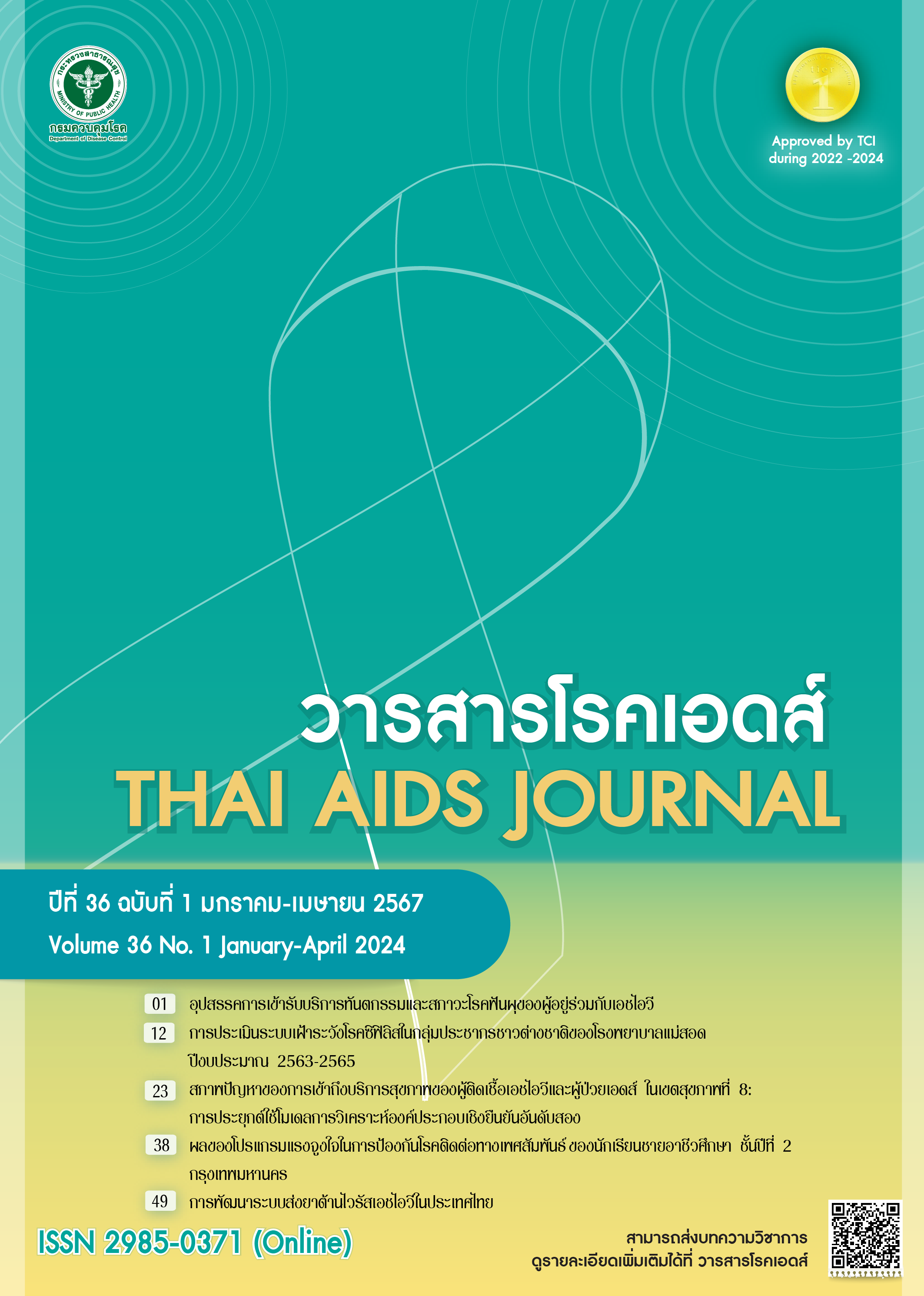The access to health services for HIV-infected individuals and AIDS patients in Health Region 8: application of the second order confirmatory factor analysis model
DOI:
https://doi.org/10.14456/taj.2024.3Keywords:
challenge, access to healthcare services, HIV-infected individuals, AIDS patient, Health Region 8Abstract
This research aimed to examine the model of the access to healthcare services for HIV-infected individuals and AIDS patients in Health Region 8, using empirical data. The data were collected through questionnaires completed by a sample of 400 HIV-infected individuals and AIDS patients in Health Region 8, who were selected based on multi-stage randomization. The data were then analyzed using confirmatory factor analysis. The analysis showed that the model corresponded with the empirical data based on the following values: relative chi-square (X2/df) of 1.97; Goodness of Fit Index (GFI) of 0.94; Adjusted Goodness of Fit Index (AGFI) of 0.91; Comparative Fit Index (CFI) of 0.99; Standardized Root Mean Square Residual (SRMR) of 0.039; and Root Mean Square Error of Approximation (RMSEA) of 0.049. The burden of access to health services for HIV-infected individuals and AIDS patients in Health Region 8 comprised six components as follows: (1) financial capacity of service recipients; (2) service quality; (3) adequacy of service locations; (4) facilities of service; (5) ability to access health care services; and (6) attitude of service recipients, respectively ordered by the weight of standardized components.
Downloads
References
Division of AIDS and STIs, Department of Disease Control. End inequalities. End AIDS. End pandemics [Internet]. Nonthaburi: Division of AIDS and STIs; 2021 [cited 2021 Dec 21]. Available from: https://ddc.moph.go.th/uploads/publish/1191420211027083955.pdf (in Thai)
Department of Disease Control. Thailand national guidelines on HIV/AIDS treatment and prevention 2021/2022. Nonthaburi: Department of Disease Control; 2022. (in Thai)
Na Ranong S. Factors predicting quality of life of HIV infected and AIDS patients in Huai Yot Hospital, Trang Province. Thai AIDS Journal. 2021;33(2):58-72. (in Thai)
National Health Security Office. Information Service Center providing services for people living with HIV [Internet]. Bangkok: National Health Security Office; 2023 [cited 2023 Apr 7]. Available from: https://www.nhso.go.th/page/online_service. (in Thai)
Department of Disease Control. Action plans for ending AIDS, Thailand 2023-2026. Nonthaburi: Department of Disease Control; 2023. (in Thai)
Kronfol NM. Access and barriers to health care delivery in Arab countries: a review. East Mediterr Health J. 2012;18(12):1239-46.
Mongkhonsuebsakul W. Thailand's access to healthcare services: the reflection and inequality of vulnerable group. Sau Journal of Social Sciences & Humanities. 2022;6(1):55-69. (in Thai)
Booshehri LG, Dugan J. Overcoming barriers to access health Care: the challenges facing minorities and immigrants in Washington State [Internet]. Washington DC: University of Washington; 2021 [cited 2021 Aug 31]. Available from: https://evans.uw.edu/overcoming-barriers-to-access-health-care-the-challenges-facing-minorities-and-immigrants-in-washington-state/
O’Donnell O. Access to health care in developing countries: breaking down demand side barriers. Cad Saude Publica. 2007;23(12):2820-34.
Chanklin U. Factors influencing access to health service of HIV and AIDS patients in Phichit Province. Phichit Public Health Research and Academic Journal. 2022;3(2):10-9. (in Thai)
Binhosen V, Jamkrajang T. Factors predicting health promoting behaviors of persons with HIV/AIDS. The Journal of Nursing Burapha University. 2013;21(1):65-79. (in Thai)
Chanond L. Evaluation of national access to antiretroviral program for people living with HIV/AIDS (NAPHA) in Kanchanaburi province (2004-2006). Journal of Health Science. 2006;15(4):632-37. (in Thai)
Angsuchoti S, Wijitwanna S, Pinyopanuwat R. Statistical analysis for the behavioral and social science research: technical using LISREL program. Bangkok: Mission Media; 2008. (in Thai)
Persinger G. Pharmaceutical benefits under state medical assistant programs [Internet]. Washington, DC: National Pharmaceutical Council; 2000 [cited 2023 March 2]. Available from: http://www.npcnow.org/pdf/assistpro/appendixe.pdf
Gulliford M, Figueroa-Munoz J, Morgan M, Hughes D, Gibson B, Beech R, et al. What does access to health care mean. J Health Serv Res Policy. 2002;7(3):186-8.
Penchansky R, Thomas JW. The concept of access: definition and relationship to consumer satisfaction. Med Care. 1981;19(2):127-40.
Tharnthanaboon W, Charoennavee P. Stigma and discrimination related to HIV in the Health Services Area 10, Thailand. Thai AIDS Journal. 2023;35(1):14-32. (in Thai)
Tangpatomwong N. The stigmatized communication towards HIV/AIDS patients: representation and its meaning in the quality of life of infected persons. Thai AIDS Journal. 2019;31(3):103-15. (in Thai)
Nopchanasuphap K. Access to health services of migrant workers in Mueang district, Pattani province [Master’s Thesis]. Pattani: Prince of Songkla University; 2019. 118 p. (in Thai)
Chansugree P, Rungjindarat N, Jiwton P. Inequalities in access to healthcare services in Thailand: a case study of citizens covered by the universal coverage scheme. Bangkok: National Institute of Development Administration; 2017. (in Thai)
International Health Policy Program. Pilot research developing tools and methods to explore stigma and discrimination related to HIV/AIDS. in health service facilities in Thailand. Nonthaburi: Ministry of Public Health; 2014. (in Thai)
Prachuntasen K. Influences of social capital, accessibility to health services and quality of life of middle aged and elderly in the Northeast of Thailand [Doctor of Public Heath Thesis]. Khon Kaen: Khon Kaen University; 2018. 162 p. (in Thai)
Nunnally JC. Psychometric theory. New York: McGraw-Hill; 1967.
Marsh HW, Hau KT, Balla JR, Grayson D. Is more ever too much? the number of indicators per factor in confirmatory factor analysis. Multivariate Behav Res. 1998;33(2):181-220.
Pasunon P. Validity of questionnaire for social science research. Journal of Social Sciences Srinakharinwirot University. 2015;18:375-96. (in Thai)
Cortina JM. What is coefficient alpha: an examination of theory and applications. Journal of Applied Psychology. 1993;78(1):98-104.
Thakkar JJ. Structural equation modelling: application for and practice (with AMOS and R). Singapore: Springer; 2020.
Hair JF, Black WC, Babin BJ, Anderson RE. Multivariate data analysis. 7th ed. Harlow, United Kingdom: Pearson Education; 2014.
Sittikan S, Jongudomkarn D. Barriers to access of primary healthcare by people with low income in urban communities: a qualitative study. Journal of Nursing Science & Health. 2020;43(1):19-29. (in Thai)
Scheil-Adlung X, Kuhl C. Addressing inequities in access to health care for vulnerable groups in countries of Europe and Central Asia. Geneva: International Labour Office; 2011.



